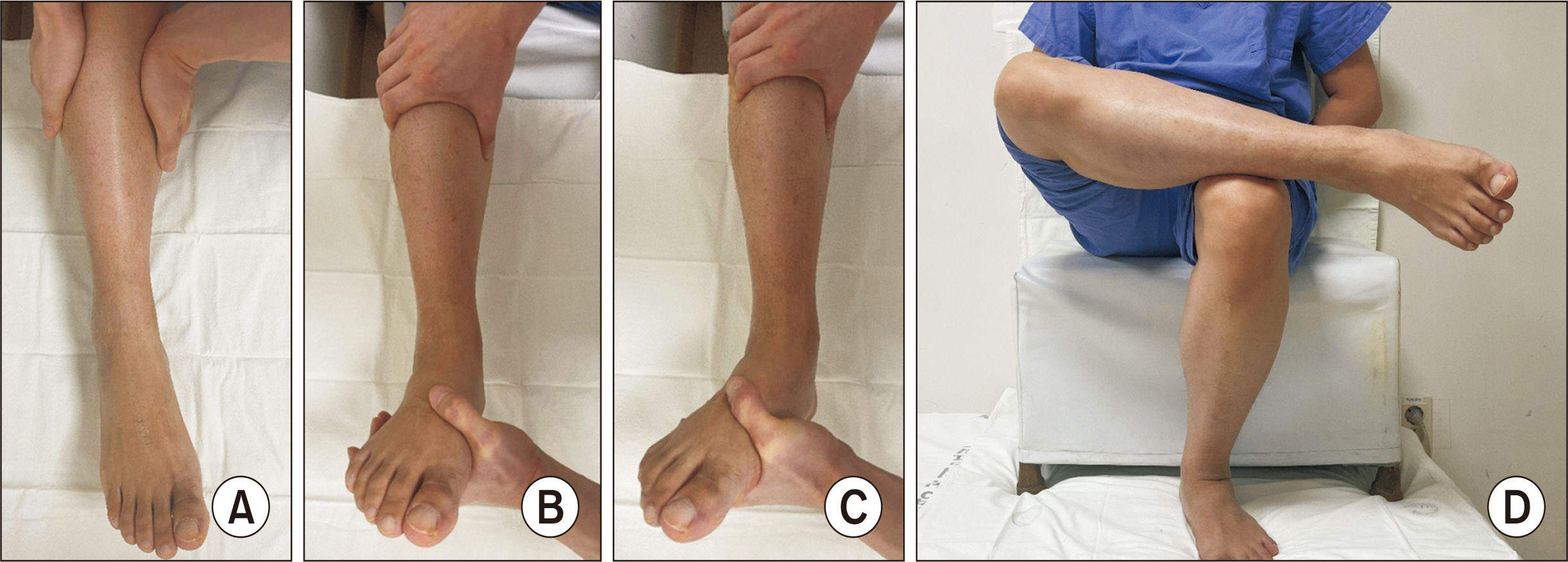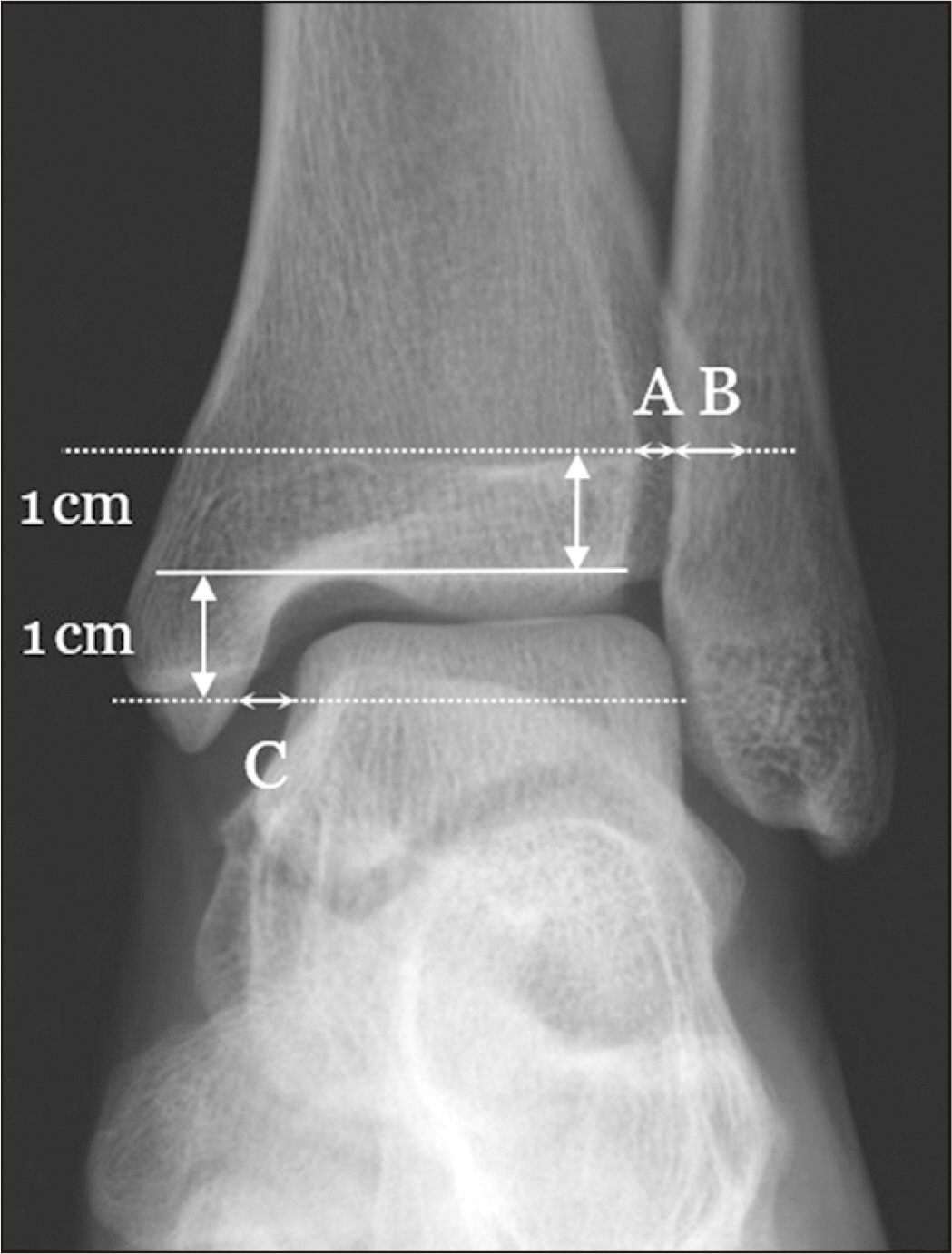J Korean Foot Ankle Soc.
2022 Mar;26(1):9-15. 10.14193/jkfas.2022.26.1.9.
Syndesmotic Injury
- Affiliations
-
- 1Department of Orthopaedic Surgery, College of Medicine, Kyung Hee University, Seoul, Korea
- KMID: 2527006
- DOI: http://doi.org/10.14193/jkfas.2022.26.1.9
Abstract
- Syndesmotic injuries are found frequently in clinical practice, and they remain controversial because of the variety of diagnostic techniques and management options. Bony avulsions or malleolar fractures are commonly associated with syndesmotic disruptions. Even unstable isolated syndesmosis injuries are associated with a latent or frank tibiofibular diastasis and should not be ignored in the early phase. A relevant instability of the syndesmosis with diastasis results from collateral ligaments tears and requires operative stabilization.The treatment involves an anatomic reduction of the distal tibiofibular articulations followed by stable fixation. Syndesmotic transfixation screws or suture button implants are being proposed as a means of fixation. Recently, suture button fixation has shown more favorable outcomes, but the outcomes can still be controversial. Syndesmotic malreduction can lead to hardware failure, adhesions, heterotopic ossification, tibiofibular synostosis, chronic instability, and posttraumatic arthritis. In particular, the correct diagnosis and evidencebased treatment options for unstable syndesmotic injury should be considered.
Figure
Reference
-
1. Fallat L, Grimm DJ, Saracco JA. 1998; Sprained ankle syndrome: prevalence and analysis of 639 acute injuries. J Foot Ankle Surg. 37:280–5. doi: 10.1016/S1067-2516(98)80063-X. DOI: 10.1016/S1067-2516(98)80063-X. PMID: 9710779.
Article2. Zalavras C, Thordarson D. 2007; Ankle syndesmotic injury. J Am Acad Orthop Surg. 15:330–9. doi: 10.5435/00124635-200706000-00002. DOI: 10.5435/00124635-200706000-00002. PMID: 17548882.
Article3. Marti RK, Raaymakers EL, Nolte PA. 1990; Malunited ankle fractures. The late results of reconstruction. J Bone Joint Surg Br. 72:709–13. doi: 10.1302/0301-620X.72B4.2116416. DOI: 10.1302/0301-620X.72B4.2116416. PMID: 2116416.
Article4. Boden SD, Labropoulos PA, McCowin P, Lestini WF, Hurwitz SR. 1989; Mechanical considerations for the syndesmosis screw. A cadaver study. J Bone Joint Surg Am. 71:1548–55. DOI: 10.2106/00004623-198971100-00014. PMID: 2512295.
Article5. Rasmussen O, Tovborg-Jensen I, Boe S. 1982; Distal tibiofibular ligaments. Analysis of function. Acta Orthop Scand. 53:681–6. doi: 10.3109/17453678208992276. DOI: 10.3109/17453678208992276. PMID: 7102288.6. Ogilvie-Harris DJ, Reed SC, Hedman TP. 1994; Disruption of the ankle syndesmosis: biomechanical study of the ligamentous restraints. Arthroscopy. 10:558–60. doi: 10.1016/S0749-8063(05)80014-3. DOI: 10.1016/S0749-8063(05)80014-3. PMID: 7999167.
Article7. Close JR. 1956; Some applications of the functional anatomy of the ankle joint. J Bone Joint Surg Am. 38:761–81. DOI: 10.2106/00004623-195638040-00005. PMID: 13331972.
Article8. Ramsey PL, Hamilton W. 1976; Changes in tibiotalar area of contact caused by lateral talar shift. J Bone Joint Surg Am. 58:356–7. DOI: 10.2106/00004623-197658030-00010. PMID: 1262367.
Article9. van den Bekerom MP, Lamme B, Hogervorst M, Bolhuis HW. 2007; Which ankle fractures require syndesmotic stabilization? J Foot Ankle Surg. 46:456–63. doi: 10.1053/j.jfas.2007.08.009. DOI: 10.1053/j.jfas.2007.08.009. PMID: 17980843.
Article10. Jenkinson RJ, Sanders DW, Macleod MD, Domonkos A, Lydestadt J. 2005; Intraoperative diagnosis of syndesmosis injuries in external rotation ankle fractures. J Orthop Trauma. 19:604–9. doi: 10.1097/01.bot.0000177114.13263.12. DOI: 10.1097/01.bot.0000177114.13263.12. PMID: 16247304.
Article11. Hopkinson WJ, St Pierre P, Ryan JB, Wheeler JH. 1990; Syndesmosis sprains of the ankle. Foot Ankle. 10:325–30. doi: 10.1177/107110079001000607. DOI: 10.1177/107110079001000607. PMID: 2113510.
Article12. Sikka RS, Fetzer GB, Sugarman E, Wright RW, Fritts H, Boyd JL, et al. 2012; Correlating MRI findings with disability in syndesmotic sprains of NFL players. Foot Ankle Int. 33:371–8. doi: 10.3113/FAI.2012.0371. DOI: 10.3113/FAI.2012.0371. PMID: 22735278.
Article13. Kiter E, Bozkurt M. 2005; The crossed-leg test for examination of ankle syndesmosis injuries. Foot Ankle Int. 26:187–8. doi: 10.1177/107110070502600213. DOI: 10.1177/107110070502600213. PMID: 15737264.
Article14. Beumer A, van Hemert WL, Niesing R, Entius CA, Ginai AZ, Mulder PG, et al. Radiographic measurement of the distal tibiofibular syndesmosis has limited use. Clin Orthop Relat Res. 2004; (423):227–34. doi: 10.1097/01.blo.0000129152.81015.ad. DOI: 10.1097/01.blo.0000129152.81015.ad. PMID: 15232454.
Article15. Pneumaticos SG, Noble PC, Chatziioannou SN, Trevino SG. 2002; The effects of rotation on radiographic evaluation of the tibiofibular syndesmosis. Foot Ankle Int. 23:107–11. doi: 10.1177/107110070202300205. DOI: 10.1177/107110070202300205. PMID: 11858329.
Article16. Edwards GS Jr, DeLee JC. 1984; Ankle diastasis without fracture. Foot Ankle. 4:305–12. doi: 10.1177/107110078400400606. DOI: 10.1177/107110078400400606. PMID: 6429020.
Article17. Takao M, Ochi M, Oae K, Naito K, Uchio Y. 2003; Diagnosis of a tear of the tibiofibular syndesmosis. The role of arthroscopy of the ankle. J Bone Joint Surg Br. 85:324–9. doi: 10.1302/0301-620X.85B3.13174. DOI: 10.1302/0301-620X.85B3.13174. PMID: 12729102.18. Vogl TJ, Hochmuth K, Diebold T, Lubrich J, Hofmann R, Stöckle U, et al. 1997; Magnetic resonance imaging in the diagnosis of acute injured distal tibiofibular syndesmosis. Invest Radiol. 32:401–9. doi: 10.1097/00004424-199707000-00006. DOI: 10.1097/00004424-199707000-00006. PMID: 9228606.
Article19. Oae K, Takao M, Naito K, Uchio Y, Kono T, Ishida J, et al. 2003; Injury of the tibiofibular syndesmosis: value of MR imaging for diagnosis. Radiology. 227:155–61. doi: 10.1148/radiol.2271011865. DOI: 10.1148/radiol.2271011865. PMID: 12616009.
Article20. Ebraheim NA, Lu J, Yang H, Mekhail AO, Yeasting RA. 1997; Radiographic and CT evaluation of tibiofibular syndesmotic diastasis: a cadaver study. Foot Ankle Int. 18:693–8. doi: 10.1177/107110079701801103. DOI: 10.1177/107110079701801103. PMID: 9391813.
Article21. Mei-Dan O, Kots E, Barchilon V, Massarwe S, Nyska M, Mann G. 2009; A dynamic ultrasound examination for the diagnosis of ankle syndesmotic injury in professional athletes: a preliminary study. Am J Sports Med. 37:1009–16. doi: 10.1177/0363546508331202. DOI: 10.1177/0363546508331202. PMID: 19336613.22. Espinosa N, Smerek JP, Myerson MS. 2006; Acute and chronic syndesmosis injuries: pathomechanisms, diagnosis and management. Foot Ankle Clin. 11:639–57. doi: 10.1016/j.fcl.2006.07.006. DOI: 10.1016/j.fcl.2006.07.006. PMID: 16971254.
Article23. van den Bekerom MP, de Leeuw PA, van Dijk CN. 2009; Delayed operative treatment of syndesmotic instability. Current concepts review. Injury. 40:1137–42. doi: 10.1016/j.injury.2009.03.011. DOI: 10.1016/j.injury.2009.03.011. PMID: 19524232.
Article24. Gerber JP, Williams GN, Scoville CR, Arciero RA, Taylor DC. 1998; Persistent disability associated with ankle sprains: a prospective examination of an athletic population. Foot Ankle Int. 19:653–60. doi: 10.1177/107110079801901002. DOI: 10.1177/107110079801901002. PMID: 9801078.
Article25. Rammelt S, Zwipp H, Grass R. 2008; Injuries to the distal tibiofibular syndesmosis: an evidence-based approach to acute and chronic lesions. Foot Ankle Clin. 13:611–33. vii–viii. doi: 10.1016/j.fcl.2008.08.001. DOI: 10.1016/j.fcl.2008.08.001. PMID: 19013399.
Article26. Magan A, Golano P, Maffulli N, Khanduja V. 2014; Evaluation and management of injuries of the tibiofibular syndesmosis. Br Med Bull. 111:101–15. doi: 10.1093/bmb/ldu020. DOI: 10.1093/bmb/ldu020. PMID: 25190761.
Article27. Miller TL, Skalak T. 2014; Evaluation and treatment recommendations for acute injuries to the ankle syndesmosis without associated fracture. Sports Med. 44:179–88. doi: 10.1007/s40279-013-0106-1. DOI: 10.1007/s40279-013-0106-1. PMID: 24127279.
Article28. Han SH, Lee JW, Kim S, Suh JS, Choi YR. 2007; Chronic tibiofibular syndesmosis injury: the diagnostic efficiency of magnetic resonance imaging and comparative analysis of operative treatment. Foot Ankle Int. 28:336–42. doi: 10.3113/FAI.2007.0336. DOI: 10.3113/FAI.2007.0336. PMID: 17371657.
Article29. Ebraheim NA, Elgafy H, Padanilam T. Syndesmotic disruption in low fibular fractures associated with deltoid ligament injury. Clin Orthop Relat Res. 2003; (409):260–7. doi: 10.1097/01.blo.0000052935.71325.30. DOI: 10.1097/01.blo.0000052935.71325.30. PMID: 12671510.
Article30. Thompson MC, Gesink DS. 2000; Biomechanical comparison of syndesmosis fixation with 3.5- and 4.5-millimeter stainless steel screws. Foot Ankle Int. 21:736–41. doi: 10.1177/107110070002100904. DOI: 10.1177/107110070002100904. PMID: 11023220.
Article31. Needleman RL, Skrade DA, Stiehl JB. 1989; Effect of the syndesmotic screw on ankle motion. Foot Ankle. 10:17–24. doi: 10.1177/107110078901000104. DOI: 10.1177/107110078901000104. PMID: 2767562.
Article32. Heim D, Heim U, Regazzoni P. 1993; [Malleolar fractures with ankle joint instability--experience with the positioning screw]. Unfallchirurgie. 19:307–12. German doi: 10.1007/BF02588127. DOI: 10.1007/BF02588127. PMID: 8273262.33. Tornetta P 3rd, Spoo JE, Reynolds FA, Lee C. 2001; Overtightening of the ankle syndesmosis: is it really possible? J Bone Joint Surg Am. 83:489–92. doi: 10.2106/00004623-200104000-00002. DOI: 10.2106/00004623-200104000-00002. PMID: 11315776.
Article34. Kukreti S, Faraj A, Miles JN. 2005; Does position of syndesmotic screw affect functional and radiological outcome in ankle fractures? Injury. 36:1121–4. doi: 10.1016/j.injury.2005.01.014. DOI: 10.1016/j.injury.2005.01.014. PMID: 16051235.
Article35. Reckling FW, McNamara GR, DeSmet AA. 1981; Problems in the diagnosis and treatment of ankle injuries. J Trauma. 21:943–50. doi: 10.1097/00005373-198111000-00006. DOI: 10.1097/00005373-198111000-00006. PMID: 7299863.
Article36. Baek JH, Kim TY, Kwon YB, Jeong BO. 2018; Radiographic change of the distal tibiofibular joint following removal of transfixing screw fixation. Foot Ankle Int. 39:318–25. doi: 10.1177/1071100717745526. DOI: 10.1177/1071100717745526. PMID: 29278930.
Article37. Lee SY, Moon SY, Park MS, Jo BC, Jeong H, Lee KM. 2018; Syndesmosis fixation in unstable ankle fractures using a partially threaded 5.0-mm cannulated screw. J Foot Ankle Surg. 57:721–5. doi: 10.1053/j.jfas.2017.12.012. DOI: 10.1053/j.jfas.2017.12.012. PMID: 29705234.
Article38. Fites B, Kunes J, Madaleno J, Silvestri P, Johnson DL. 2006; Latent syndesmosis injuries in athletes. Orthopedics. 29:124–7. doi: 10.3928/01477447-20060201-08. DOI: 10.3928/01477447-20060201-08. PMID: 16485455.
Article39. Shimozono Y, Hurley ET, Myerson CL, Murawski CD, Kennedy JG. 2019; Suture button versus syndesmotic screw for syndesmosis injuries: a meta-analysis of randomized controlled trials. Am J Sports Med. 47:2764–71. doi: 10.1177/0363546518804804. DOI: 10.1177/0363546518804804. PMID: 30475639.
Article40. Naqvi GA, Shafqat A, Awan N. 2012; Tightrope fixation of ankle syndesmosis injuries: clinical outcome, complications and technique modification. Injury. 43:838–42. doi: 10.1016/j.injury.2011.10.002. DOI: 10.1016/j.injury.2011.10.002. PMID: 22036451.
Article41. Cottom JM, Hyer CF, Philbin TM, Berlet GC. 2008; Treatment of syndesmotic disruptions with the Arthrex Tightrope: a report of 25 cases. Foot Ankle Int. 29:773–80. doi: 10.3113/FAI.2008.0773. DOI: 10.3113/FAI.2008.0773. PMID: 18752774.
Article42. Qamar F, Kadakia A, Venkateswaran B. 2011; An anatomical way of treating ankle syndesmotic injuries. J Foot Ankle Surg. 50:762–5. doi: 10.1053/j.jfas.2011.07.001. DOI: 10.1053/j.jfas.2011.07.001. PMID: 21962383.
Article43. Naqvi GA, Cunningham P, Lynch B, Galvin R, Awan N. 2012; Fixation of ankle syndesmotic injuries: comparison of tightrope fixation and syndesmotic screw fixation for accuracy of syndesmotic reduction. Am J Sports Med. 40:2828–35. doi: 10.1177/0363546512461480. DOI: 10.1177/0363546512461480. PMID: 23051785.44. Thornes B, Shannon F, Guiney AM, Hession P, Masterson E. Suture-button syndesmosis fixation: accelerated rehabilitation and improved outcomes. Clin Orthop Relat Res. 2005; (431):207–12. doi: 10.1097/01.blo.0000151845.75230.a0. DOI: 10.1097/01.blo.0000151845.75230.a0. PMID: 15685077.45. Schepers T. 2012; Acute distal tibiofibular syndesmosis injury: a systematic review of suture-button versus syndesmotic screw repair. Int Orthop. 36:1199–206. doi: 10.1007/s00264-012-1500-2. DOI: 10.1007/s00264-012-1500-2. PMID: 22318415. PMCID: PMC3353089.
Article46. Parlamas G, Hannon CP, Murawski CD, Smyth NA, Ma Y, Kerkhoffs GM, et al. 2013; Treatment of chronic syndesmotic injury: a systematic review and meta-analysis. Knee Surg Sports Traumatol Arthrosc. 21:1931–9. doi: 10.1007/s00167-013-2515-y. DOI: 10.1007/s00167-013-2515-y. PMID: 23620248.
Article47. Harper MC. 2001; Delayed reduction and stabilization of the tibiofibular syndesmosis. Foot Ankle Int. 22:15–8. doi: 10.1177/107110070102200103. DOI: 10.1177/107110070102200103. PMID: 11206818.
Article48. Zamzami MM, Zamzam MM. 2009; Chronic isolated distal tibiofibular syndesmotic disruption: diagnosis and management. Foot Ankle Surg. 15:14–9. doi: 10.1016/j.fas.2008.04.002. DOI: 10.1016/j.fas.2008.04.002. PMID: 19218059.
Article49. Yasui Y, Takao M, Miyamoto W, Innami K, Matsushita T. 2011; Anatomical reconstruction of the anterior inferior tibiofibular ligament for chronic disruption of the distal tibiofibular syndesmosis. Knee Surg Sports Traumatol Arthrosc. 19:691–5. doi: 10.1007/s00167-010-1311-1. DOI: 10.1007/s00167-010-1311-1. PMID: 21063681.
Article50. Olson KM, Dairyko GH Jr, Toolan BC. 2011; Salvage of chronic instability of the syndesmosis with distal tibiofibular arthrodesis: functional and radiographic results. J Bone Joint Surg Am. 93:66–72. doi: 10.2106/JBJS.J.00030. DOI: 10.2106/JBJS.J.00030. PMID: 21209270.
Article
- Full Text Links
- Actions
-
Cited
- CITED
-
- Close
- Share
- Similar articles
-
- Isolated Syndesmotic Injury
- Comparative Analysis of Trans-syndesmotic Versus Non-syndesmotic Screw Fixation in Surgical Treatment of Ankle Fracture with Diastasis
- Comparative analysis for syndesmotic Fixation vs Non-syndesmotic Fixation of distal Tibiofibular Diastasis
- Ankle Syndesmotic Injury
- Comparison between Suture-Button Technique with Syndesmotic Repair and Screw Fixation Technique for Complete Ankle Syndesmotic Injury: Biomechanical Cadaveric Study




